“Accuracy and speed, hand in hand – setting up your co-witness sight configuration.”
Benefits of Co-Witness Sight Configuration
Co-witness sight configuration is a popular setup for firearms enthusiasts who want to maximize their accuracy and precision. By aligning two sights on the same plane, shooters can quickly acquire their target and make more accurate shots. In this article, we will discuss the benefits of co-witness sight configuration and how to set it up on your firearm.
One of the primary advantages of using a co-witness sight configuration is that it allows for increased accuracy when aiming. By aligning both the iron sights and a red dot or holographic sight on the same plane, shooters can quickly acquire their target and make more precise shots. This setup is especially useful in fast-paced shooting situations where every second counts.
Another benefit of co-witness sight configuration is that it provides redundancy in case one sight fails. If your red dot or holographic sight malfunctions, you can easily switch to your iron sights without missing a beat. This added layer of security can be crucial in high-pressure situations where reliability is key.
Setting up a co-witness sight configuration is relatively simple and can be done with just a few tools. First, you will need to mount your red dot or holographic sight onto your firearm using the appropriate mounting system. Make sure to securely attach the sight to prevent any movement during shooting.
Next, you will need to adjust the height of your iron sights to align them with your red dot or holographic sight. Most iron sights have adjustable elevation and windage settings that allow you to fine-tune their position. Take your time to ensure that both sights are perfectly aligned on the same plane.
Once you have adjusted the height of your iron sights, you can test your co-witness sight configuration at the range. Start by zeroing in your red dot or holographic sight at a set distance and then confirm that your iron sights are also aligned with the point of impact. Make any necessary adjustments until both sights are perfectly aligned.
In conclusion, setting up a co-witness sight configuration offers several benefits for shooters looking to enhance their accuracy and precision. By aligning both iron sights and a red dot or holographic sight on the same plane, shooters can quickly acquire their target and make more accurate shots. This setup also provides redundancy in case one sight fails, adding an extra layer of security in high-pressure situations.
If you are interested in improving your shooting skills and maximizing your accuracy, consider setting up a co-witness sight configuration on your firearm. With just a few simple steps, you can enjoy the benefits of this popular setup and take your shooting to the next level.
Choosing the Right Optic and Iron Sights
When it comes to setting up your firearm for optimal accuracy and versatility, choosing the right optic and iron sights is crucial. One popular configuration that many shooters opt for is a co-witness sight setup. This configuration allows you to use both your optic and iron sights simultaneously, giving you the benefits of both systems in one setup.
To set up a co-witness sight configuration, you will need to choose the right optic and iron sights that are compatible with each other. The first step is to select an optic that allows for co-witnessing with your iron sights. This means that the optic is mounted at the same height as your iron sights, allowing you to see both aiming systems through the same sight picture.
There are several different types of optics that are commonly used in co-witness sight configurations, including red dot sights, holographic sights, and magnified optics. Each type of optic has its own advantages and disadvantages, so it’s important to choose one that best fits your shooting needs and preferences.
Once you have chosen an optic, you will need to select iron sights that are compatible with your chosen optic. Most modern firearms come equipped with some form of iron sights, but if yours do not or if you prefer a different style of iron sights, there are many aftermarket options available.
When selecting iron sights for a co-witness setup, it’s important to choose sights that are designed to be used in conjunction with an optic. These sights will typically be lower profile and designed to allow for a clear sight picture when looking through the optic.
After selecting your optic and iron sights, the next step is to mount them on your firearm. Most optics will come with mounting hardware that allows you to attach them to a Picatinny or Weaver rail on your firearm. Iron sights can be mounted directly to the firearm or attached to the optic mount, depending on your preference.
When mounting your optics and iron sights, it’s important to ensure that they are properly aligned so that they co-witness correctly. This can be done by adjusting the height of the optic or using shims or risers to achieve the proper alignment.
Once your optics and iron sights are mounted and properly aligned, it’s important to zero them in so that they are accurate when shooting. This can be done by adjusting the windage and elevation settings on both the optic and iron sights until they are hitting where you aim.
In conclusion, setting up a co-witness sight configuration can greatly enhance your shooting capabilities by allowing you to use both your optic and iron sights simultaneously. By choosing the right optic and iron sights, mounting them correctly, and zeroing them in properly, you can create a setup that is both versatile and accurate for all of your shooting needs. So next time you’re setting up your firearm, consider a co-witness sight configuration for maximum effectiveness on the range or in the field.
Step-by-Step Guide to Mounting Optic and Iron Sights

If you’re looking to optimize your shooting accuracy, a co-witness sight configuration can be a game-changer. This setup allows you to use both an optic and iron sights simultaneously, giving you the best of both worlds when it comes to aiming precision. In this step-by-step guide, we’ll walk you through how to set up a co-witness sight configuration on your firearm.
The first step in setting up a co-witness sight configuration is to choose the right optic and iron sights for your firearm. Make sure that the height of your iron sights is compatible with the height of your optic, as this will determine how well they co-witness together. Once you have the right equipment, you can move on to mounting your optic.
Start by attaching your optic to your firearm using the appropriate mounting hardware. Make sure that the optic is securely fastened and aligned properly with your barrel. Once the optic is in place, you can move on to mounting your iron sights.
To mount your iron sights, you’ll need to find a suitable location on your firearm where they won’t interfere with the optic’s field of view. Many shooters prefer to mount their iron sights on a 45-degree offset from the optic, allowing for quick transitions between the two aiming systems. Once you’ve found the right location, attach your iron sights using the appropriate hardware.
With both your optic and iron sights securely mounted, it’s time to zero them in for optimal accuracy. Start by zeroing in your optic using a boresighter or laser bore sighter. Once your optic is dialed in, you can move on to zeroing in your iron sights.
To zero in your iron sights, start by shooting at a target from a stable shooting position. Adjust the windage and elevation on your iron sights until they are hitting the target consistently. Once both your optic and iron sights are zeroed in, you’re ready to test out your new co-witness sight configuration.
Take some time to practice using both your optic and iron sights together to get a feel for how they work in tandem. You may find that one system works better for certain situations than the other, so it’s important to be comfortable with both aiming systems. With practice, you’ll be able to seamlessly transition between your optic and iron sights with ease.
In conclusion, setting up a co-witness sight configuration can greatly enhance your shooting accuracy and versatility on the range or in the field. By following these simple steps and practicing with your new setup, you’ll be well on your way to becoming a more proficient shooter. So go ahead and give it a try – you’ll be amazed at how much of a difference it can make in your shooting performance!
Zeroing Your Co-Witness Sight Configuration
When setting up a co-witness sight configuration on your firearm, it’s important to ensure that both the primary sight and the backup sight are properly zeroed. This will ensure that both sights are aligned and will allow for quick and accurate target acquisition in the event that one of the sights becomes unusable. In this article, we will discuss how to zero your co-witness sight configuration to ensure optimal performance.
First, it’s important to understand what a co-witness sight configuration is. A co-witness sight configuration involves mounting a primary optic, such as a red dot sight or holographic sight, along with a backup iron sight on the same plane. This allows the shooter to use either sight independently or simultaneously, providing redundancy in case one sight fails.
To zero your co-witness sight configuration, start by zeroing your primary optic. This can be done using the adjustments on the optic itself. Follow the manufacturer’s instructions for adjusting windage and elevation until your primary optic is zeroed at your desired distance.
Once your primary optic is zeroed, it’s time to zero your backup iron sight. To do this, you will need to align the iron sights with the point of impact of your primary optic. This can be done by adjusting the front and rear sights until they are in alignment with the red dot or reticle of your primary optic.
When zeroing your backup iron sight, it’s important to remember that the point of impact may not always be exactly where you expect it to be. Factors such as barrel length, ammunition type, and shooting position can all affect where your shots land. It may take some trial and error to get your backup iron sight properly zeroed.
One technique for zeroing your backup iron sight is to use a boresighter or laser bore tool. This will allow you to visually see where your shots are landing in relation to your sights, making it easier to make adjustments.
Once both your primary optic and backup iron sight are zeroed, it’s time to confirm that they are properly aligned. This can be done by looking through both sights simultaneously and ensuring that they are both pointing at the same point of aim. If they are not aligned, you may need to make further adjustments to one or both sights.
It’s also important to periodically check and re-zero your co-witness sight configuration to ensure that it remains accurate. Factors such as temperature changes, recoil, and gun handling can all affect the zero of your sights over time.
In conclusion, setting up a co-witness sight configuration involves properly zeroing both your primary optic and backup iron sight. By following these steps and taking the time to ensure that both sights are aligned and zeroed, you can maximize the effectiveness of your co-witness setup and be prepared for any situation that may arise in the field.
Tips for Maintaining and Adjusting Co-Witness Sights
Co-witness sights are a popular choice among firearm enthusiasts for their versatility and ease of use. By aligning both iron sights and a red dot or holographic sight, shooters can quickly switch between aiming methods without having to make any adjustments. However, setting up a co-witness sight configuration can be a bit tricky if you’re not familiar with the process. In this article, we’ll walk you through the steps to properly set up your co-witness sights and offer some tips for maintaining and adjusting them.
To begin, you’ll need to choose the type of co-witness sight configuration that best suits your needs. There are two main types: absolute and lower 1/3 co-witness. Absolute co-witness aligns the iron sights and the red dot or holographic sight at the same height, while lower 1/3 co-witness positions the iron sights slightly below the red dot or holographic sight. Both configurations have their advantages, so it’s important to choose the one that works best for you.
Once you’ve decided on a co-witness sight configuration, it’s time to install your sights. Start by mounting your red dot or holographic sight on your firearm according to the manufacturer’s instructions. Make sure it is securely attached and properly aligned with the bore of the gun. Next, install your iron sights on the same rail or mount as your red dot or holographic sight. Adjust them so they line up with your red dot or holographic sight when looking through both at the same time.
After installing your co-witness sights, it’s important to zero them for accuracy. Start by zeroing in your red dot or holographic sight at a specific distance, such as 25 yards. Once you have achieved a consistent point of aim with your red dot or holographic sight, adjust your iron sights to match. This may require some trial and error, so be patient and make small adjustments until both sets of sights are perfectly aligned.
To maintain your co-witness sight configuration, regularly check for any loose screws or mounting hardware. Tighten any loose components to ensure that your sights remain secure during use. It’s also a good idea to clean your sights regularly to prevent dirt and debris from obstructing your view. Use a soft brush or cloth to gently wipe down your sights and remove any buildup that could affect their performance.
If you find that your co-witness sights are not holding zero or are consistently off target, it may be time to make some adjustments. Start by checking for any obvious issues, such as loose mounting hardware or damaged components. If everything looks good, consider re-zeroing your sights at a different distance or under different shooting conditions. Sometimes environmental factors can affect the accuracy of your sights, so it’s important to experiment and find what works best for you.
In conclusion, setting up a co-witness sight configuration is a straightforward process that can greatly improve your shooting accuracy and speed. By following these tips for maintaining and adjusting your co-witness sights, you can ensure that they remain reliable and effective in any shooting situation. Remember to choose the right configuration for your needs, install your sights properly, zero them accurately, and regularly check for any issues that may arise. With proper care and attention, your co-witness sights will serve you well for years to come.





